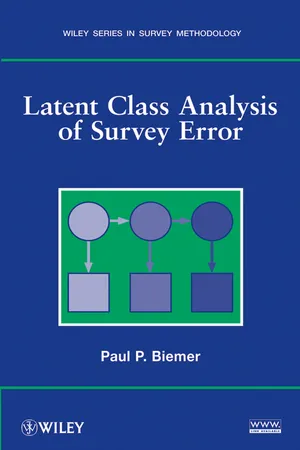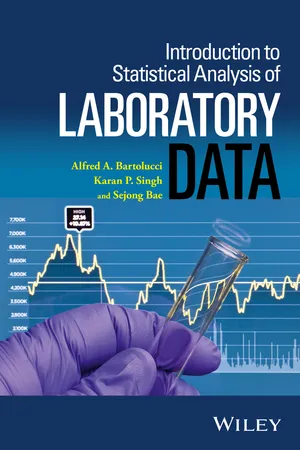Mathematics
Estimator Bias
Estimator bias refers to the tendency of an estimator to consistently overestimate or underestimate the true value of a parameter. This can occur due to various factors such as sampling error, measurement error, or the use of an inappropriate model. Estimator bias can lead to inaccurate conclusions and should be minimized or corrected for in statistical analyses.
Written by Perlego with AI-assistance
Related key terms
Related key terms
1 of 4
Related key terms
1 of 3
3 Key excerpts on "Estimator Bias"
- eBook - ePub
- Paul P. Biemer(Author)
- 2011(Publication Date)
- Wiley(Publisher)
systematic errors for each error source based on a synthesis of the nonsampling error literature. They define variable errors as errors that are distributed with zero mean and nonzero variance. Systematic errors are defined as errors having nonzero mean and zero or trivially small variance. As an example, in a survey using acceptable probability sampling methods, the sampling error distribution has zero mean and there is no risk of bias. Of course, sampling variance is an unavoidable consequence of sampling.Specification error contributes systematic errors because measuring the wrong concept in a survey causes the estimate to consistently differ from the true concept. Nonresponse error typically poses a greater risk to systematic error, although nonresponse adjustment methods such as imputation and weighting can contribute importantly to the variance, especially when the nonresponse rates are high. Frame errors, particularly noncoverage errors, are viewed primarily as a source of systematic error, although, as with nonre-sponse, coverage adjustments can also increase the variance. Measurement errors (emanating primarily from interviewers, respondents, and the questions themselves) can pose a serious risk for both systematic and variable errors, as detailed in the later chapters. Finally, data-processing operations involving human operators, such as coding and editing, can add both systematic and variable errors to the total error.Using these risk classifications, Biemer and Lyberg posit an expanded version of the MSE that is applicable to estimates of means, totals, and proportions and that includes specific terms for each major source of error. In their formulation, the B 2 component is expanded to include bias components for all the sources of error having a high risk of systematic error: specification bias, B SPEC ; frame bias, B FR ; nonresponse bias, B NR ; measurement bias, B MEAS ; and data-processing bias, B DP . These components sum together to produce the total bias component, B :(1.5)Likewise, the variance of an estimator can be decomposed into components associated with the major sources of variable error: sampling variance (Var SAMP ), measurement error variance (Var MEAS ), and data-processing variance (Var DP - eBook - ePub
Polling America
An Encyclopedia of Public Opinion [2 volumes]
- Richard L. Clark, Kelly N. Foster, Samuel J. Best, Benjamin Radcliff, Richard L. Clark, Kelly N. Foster, Samuel J. Best, Benjamin Radcliff, Richard L. Clark, Kelly N. Foster, Samuel J. Best, Benjamin Radcliff(Authors)
- 2020(Publication Date)
- Greenwood(Publisher)
For example, if exactly 50 percent all voters will vote for Candidate X but we employ a survey method that consistently and systematically excludes 10 percent of Candidate X’s supporters while excluding none of those who do not support X, then surveys using that method would produce biased results. Random variation would cause different administrations of a survey with this biased methodology to produce different results; random variation even makes it possible that a survey with this method would produce an estimate that was exactly correct. However, on average, surveys with this biased method would estimate Candidate X receiving 45 percent of the vote, or 10 percent less than the true value of this statistic. Although there will still be variability in the results of surveys, the variability would center on a biased value of 45 percent of the vote, rather than the accurate value of 50 percent.Bias in surveys, as well as variation, can come from a number of sources. Survey methodologists typically think of survey error in two ways: as total survey error and as mean squared error (MSE). Both of these concepts consider the commonly discussed sampling error and myriad other possible sources of error introduced into survey estimates through the survey research process. Total survey error is the difference between the estimate for a statistic measured in a particular survey and the true value of that statistic. The MSE considers not only error associated with the variability of survey statistics but also systematic bias.The MSE is a concept and measure commonly used to encompass both the systematic error or bias in a survey and the variable error or variance in a survey. The MSE is typically measured as the sum of the squared bias in a survey and the variance. Thus, in cases where there is no bias, the MSE is equal to the variance. The MSE applies to any specific statistic measured in a survey and might be different for different survey questions contained in the same public opinion poll. Since survey researchers can rarely know the true value of a statistic, and rarely know the bias involved in a given method, the MSE cannot typically be calculated or reported.A variety of sources can influence both bias and variance in a survey. Typically, these include both sampling error and nonsampling error. Biemer and Lyberg delineate different potential sources of survey error and their potential impact on both variable error and systematic error. Specification error, frame error, and nonresponse error all have a relatively small impact on the measured variability of survey results but have a potentially high risk for producing systematic bias. In contrast, sampling error has minimal risk of bias but has a potentially high influence on variability. Measurement error and data processing error have a potentially high impact on both variable error and systematic bias. Under this formulation, the MSE formula can be expanded to read MSE = (BSPEC + BNR + BMEAS + BDP )2 + VARSAMP + VARMEAS + VARDP - Alfred Bartolucci, Karan P. Singh, Sejong Bae(Authors)
- 2015(Publication Date)
- Wiley(Publisher)
2 data. The technique is called a nonparametric bootstrap because we are not assuming that the underlying process that generated the data follows a parametric distribution such as normality. This is a very handy technique when dealing with laboratory data that one cannot assume data is normally distributed. The only assumption we make is that the data is truly representative of the experimental process being analyzed. Also, as noted earlier, although our demonstration here was with a rather small sample, we usually need a moderately large sample for the bootstrap procedure to work well.7.5 Calibration Bias
There are many ways of expressing bias in statistics, but it is basically the difference between what is recorded and what is actually expected. For example, if Xm is the mean of the sample and μ is the actual expected or “true” mean from the population, then we say that the bias is Xm − μ. Suppose we have many labs participating in a study and using the same calibration technique and instrument for clinical chemistries. The expected resultant mean hematocrit value from all these laboratories for a particular trial sample is, say, 35.4. Suppose laboratory A derives a mean value of 34.9 for this same sample. The bias attributed to this one laboratory may be expressed as . Note that calibration reduces an error to an accepted range. The error is a precision error if it is estimated statistically. Otherwise, it is a biased error. The reader is referred to Beasley and Figliola (2000) for more details. Laboratory results can be precise but inaccurate. Inaccuracy can mean that there is bias. Bias is defined from a simple population perspective. Bias and calibration bias are examined by revisiting the method comparison procedures discussed earlier. Note that some authors discuss procedures for examining calibration bias. Some authors use the term validation of the calibration model. For our purposes, we will call it examining calibration bias. For a good discussion on the terms bias, calibration, calibration bias, calibration model, and other terms used in the literature, the reader is referred to Bias versus Calibration: http://elsmar.com/Forums/showthread.php?t=7404 .Now, let us refer to the method comparison of two instruments where one is the standard. A way to examine the bias of a new instrument versus the standard one is to plot the differences between the readings from each instrument versus the average of those readings. We refer one again to Vannest et al. (2002). Recall the section on method comparison in Chapter 3 . We also discuss bias when comparing two instruments. This is precisely what we present here when evaluating Instrument A versus the standard. Figures 7.5 –7.7
Index pages curate the most relevant extracts from our library of academic textbooks. They’ve been created using an in-house natural language model (NLM), each adding context and meaning to key research topics.
Explore more topic indexes
Explore more topic indexes
1 of 6
Explore more topic indexes
1 of 4


